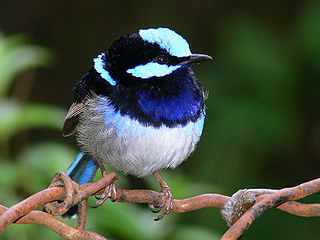Patterns of endemism
Family-level endemism is prominent in Australia. The Australasian biogeographic region has the highest number of endemic families of any zoogeographic region except the Neotropics, and many of these families are endemic to Australia itself — the country therefore stakes a strong claim to be the world's greatest hotspot of bird endemism.
Australian endemic and near-endemic families
The Australian endemic families are:
- Emu (Dromaiidae), a well-known monotypic family; the emu is found in rural areas throughout the continent
- Plains-wanderer (Pedionomidae), a monotypic family; plains-wanderer is restricted to arid inland areas in the southeast of Australia
- Lyrebirds (Menuridae), two forest-dwelling species of southeast Australia
- Scrub-birds (Atrichornithidae), two forest-dwelling species, one found in southeastern Australia, the other in southwest Australia
- Australian mudnesters (Struthideidae), two species found in open forest and woodland environments in eastern Australia
- Bristlebirds (Dasyornithidae), three species: eastern, western and rufous bristlebirds.
- Pardalotes (Pardalotidae), four species: spotted, forty-spotted, red-browed and striated pardalote
In addition to the families listed above, the following families are endemic to the Australasian region, with some of their species also found in New Guinea:
- Magpie goose (Anseranatidae), a monotypic family with a portion of the population living on New Guinea
- Australian treecreepers (Climacteridae), seven species, six endemic to Australia and one, the Papuan treecreeper, endemic to New Guinea.
- Bowerbirds (Ptilonorhynchidae), twenty species, ten found in Australia, eight in New Guinea, and two in both.
- Fairy-wrens, emu-wrens, and grasswrens (Maluridae), twenty-nine species, twenty-three endemic to Australia and six to New Guinea
- Australasian babblers (Pomatostomidae), four of the five species are endemic to Australia
- Logrunners (Orthonychidae), three species, two endemic to Australia and one to New Guinea
- Jewel-babblers and quail-thrushes (Cinclosomatidae), nine species, five Australian, four from New Guinea, sometimes broadened to Phosphodidae to include whipbirds and wedgebills (six species, five from Australia and one from New Guinea).
- Sittellas (Neosittidae), two species, the varied sittella of Australia and the black sittella of New Guinea
- Boatbills (Machaerirhynchidae), two species, Australia's yellow-breasted boatbill and New Guinea's black-breasted boatbill.
A further group of families endemic to the Australasian region, but where the species are predominantly New Guinea endemics are listed in the article on endemic birds of New Guinea.

The Australasian wrens are a family, Maluridae, of small, insectivorous passerine birds endemic to Australia and New Guinea. While commonly known as wrens, they are unrelated to the true wrens. The family comprises 32 species in six genera.

Threatened fauna of Australia are those species and subspecies of birds, fish, frogs, insects, mammals, molluscs, crustaceans, and reptiles to be found in Australia that are in danger of becoming extinct. This article lists species classified as threatened species under the Commonwealth Environment Protection and Biodiversity Conservation Act 1999.

The Alice Springs Desert Park is an environmental education facility and wildlife park in Alice Springs in the Northern Territory of Australia.

Forgotten Songs is a public artwork by Michael Thomas Hill located in Angel Place, Sydney. The installation was part of the 2009 Sydney Laneway Temporary art scheme, afterwards, due to the popularity of the installation, in 2011, the project was turned into a part of the 9 million dollar permanent laneway installations.
This page is based on this
Wikipedia article Text is available under the
CC BY-SA 4.0 license; additional terms may apply.
Images, videos and audio are available under their respective licenses.



